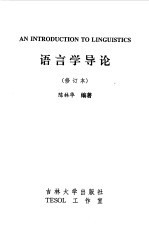图书介绍
语言学导论PDF|Epub|txt|kindle电子书版本网盘下载

- 陈林华编著;TESOL工作室编 著
- 出版社: 长春:吉林大学出版社
- ISBN:7560122337
- 出版时间:1999
- 标注页数:399页
- 文件大小:12MB
- 文件页数:411页
- 主题词:语言学
PDF下载
下载说明
语言学导论PDF格式电子书版下载
下载的文件为RAR压缩包。需要使用解压软件进行解压得到PDF格式图书。建议使用BT下载工具Free Download Manager进行下载,简称FDM(免费,没有广告,支持多平台)。本站资源全部打包为BT种子。所以需要使用专业的BT下载软件进行下载。如BitComet qBittorrent uTorrent等BT下载工具。迅雷目前由于本站不是热门资源。不推荐使用!后期资源热门了。安装了迅雷也可以迅雷进行下载!
(文件页数 要大于 标注页数,上中下等多册电子书除外)
注意:本站所有压缩包均有解压码: 点击下载压缩包解压工具
图书目录
1.Linguistics:Science of Language1
Chapter One Linguistics1
2.Scope of Linguistics2
3.Approaches to Language3
4.Grammar4
5.Schools of Linguistics5
Exercise 18
Chapter Two Language10
1.Understanding of Language10
2.Defining Features of Language11
2.1.Well-organized system of linguistic symbols11
2.2.Duality of structure12
2.4.Productivity13
2.3.Arbitrariness13
2.5.Displacement14
2.6.Transferability14
2.7.Cultural transmission14
2.8.Linearity14
3.Language,Unique to Human Beings15
4.Linguistic Competence and Linguistic Performance16
5.Social Functions of Language17
5.1.Language,a communicative means17
5.2.Language,the means for conceptual thinking and recognition of the world18
5.3.Langnage,the vehicle and transmitter of culture20
6.Language and the Human Brain20
6.2.Functions of the brain21
6.1.Structure of the human brain21
7.Conceptual Thinking of the Deaf-mute23
8.Origin of Language24
9.Animal Communication Systems25
Exercise 229
Chapter Three Phonetics:Sounds of Language30
1.Phonetic Alphabet31
2.English Consonants and Vowels34
3.Study of Phonetics39
4.Articulatory Phonetics40
4.1.Articulatory organs40
4.2.Discription of English consonants42
(1)Place of articulation44
(2)Manner of articulation46
4.3.Description of English vowels55
5.Natural Classes of Speech Sounds59
Exercise 360
Chapter Four Phonology:Sound Patterns of Language63
1.Phonemes:Phonological Units of Language64
1.1.Distinctive features65
1.2.Contrast in form and meaning67
1.3.Nondistinctive features69
1.4.Phones and allophones70
1.5.Complementary distribution71
1.6.Phonetic representation and phonemic representation72
2.Suprasegmental Features73
3.Sequences of Phonemes78
3.1.Constraints on sequences of phonemes79
3.2.Syllables80
4.Phonological Rules82
5.Formalization of Phonological Rules90
Exercise 494
Chapter Five Morphology:Structure of Words99
1.Morphemes:Smallest Meaningful Units of Language100
1.1.Morpheme101
1.2.Morph and allomorph102
1.3.Analysis of morphemes103
1.4.Derivational and inflectional morphemes105
2.Morphological Rules of Word Formation107
3.Other Ways to Form Words110
3.1.Conversion110
3.2.Abbreviation111
3.3.Back-formation111
3.4.Blending112
3.5.Onomatopoeia112
3.6.Reduplication112
3.7.Sentence-condensation113
3.8.Acronymization113
(1)Alphabetisms113
(2)Words pronounced as common words114
4.Phonetic Representation of Morphemes114
Exercise 5117
1.Grammatical Rules120
Chapter Six Syntax:Structure of Sentences120
1.1.Paradigmatic rules121
(1)Parts of speech and form classes121
(2)Inflection124
(3)Grammatical categories125
1.2.Syntagmatic rules133
(1)Combination of morphemes into words133
(2)Basic patterns of combination of words134
(3)Constituent structure136
1.3.Concord and government141
2.Grammatical Units142
3.1.Syntactic rules145
3.Sentence Patterns of Language145
3.2.Phrase-structure rules151
3.3.Fitting in morphemes and words156
3.4.Recursive rules158
3.5.Surface structure and deep structure161
3.6.Transformational rules162
3.7.Phonological and semantic components171
3.8.Ambiguity in surface structure and grammatical relationships revealed in deep structure172
Exercise 6178
Chapter Seven Semantics:Meaning of Language180
1.Meaning,Concept,Referent180
2.Sense and Reference181
3.Meaning of Morphemes and Words182
4.Semantic Features and Componential Analysis186
5.Monosemy and Polysemy187
6.Homonymy188
7.Sense Relations Between Words190
7.1.Synonymy190
7.2.Antonymy193
7.3.Hyponymy197
8.Idioms198
9.Combination of Meanings of Words201
10.Meaning of Sentences201
Excercise 7205
Chapter Eight Pragmatics:Actual Use of Language in Context208
1.Study of Pragmatics209
2.Context212
3.Speech Act Theory216
3.1.Speech acts216
3.2.Classification of performatives219
3.3.Indirect speech acts221
4.Conversational Implicature225
4.1.Basic notion of conversational implicature225
4.2.Cooperative Principle(CP)227
4.3.Politeness Principles(PP)228
5.Convensation Analysis231
5.1.Analysis of the structure of a whole conversation232
5.2.Analysis of the local structure of a conversation233
Excercise 8238
Chapter Nine Language Acquisition240
1.Stages of Child Language Acquisition241
1.1.Babbling stage241
1.2.Holophrastic stage242
1.3.Two-word stage243
1.4.Telegraphic stage244
1.5.Full language-acquistion stage245
2.Different Views on Child Language Acquistion246
2.1.Postnatal learning theory246
2.1.Innate linguistic competence theory249
Exercise 9251
Chapter Ten Language and Society252
1.Relation between Language and Society252
2.Sociolinguistics253
3.Dialects255
3.1.Geographical dialects256
3.2.Social dialects257
3.3.Styles259
3.4.Slang,jargon and taboo260
3.5.Standard and non-standard dialects263
4.Lingua Francas265
5.Pidgin and Creole Languages266
6.Esperanto:An Artificial Language273
Exercise 10275
Chapter Eleven Language,Thought and Culture276
1.Understanding of Culture276
2.2.Sapir-Whorf Hypothesis279
2.1.Relation between language and thought279
2.Language and Thought279
3.Language and Culture284
4.Cultural Overlap,Cultural Diffusion and Translatability287
5.Culture and Foreign Language Teaching and Learning290
Excercise 11296
Chapter Twelve Historical-Comparative Linguistics297
1.Grimm's Law and Verner's Law:Sound Correspondence298
2.Languages of the World300
3.Genetic Classification of Languages302
4.Language Families306
4.1.Indo-European Language Family307
4.2.Sino-Tibetan Language Family308
4.4.Caucasian Language Family309
4.3.Afro-Asiatic Language Family309
4.5.Uralic Language Family310
4.6.Altaic Language Family310
4.7.Dravidian Language Family310
4.8.Malayo-Polynesian Language Family311
4.9.Niger-Kordofanian Language Family311
5.Typological Classification of Languages312
5.1.Isolating languages313
5.2.Agglutinating languages314
5.3.Inflectional languages315
5.4.Polysynthetic languages318
6.Structural Classification of Languages318
Exercise 12321
Chapter Thirteen Language Change324
1.A Brief History of English324
2.Phonetic Changes326
3.Phonological Changes328
3.1.Changes in phonemes and phonological rules328
3.2.Great Vowel Shift331
4.Morphological Changes333
5.Syntactic Changes335
6.Lexical Changes338
6.1.Word coinage338
6.2.Borrowing338
7.Semantic Changes343
7.1.Broadening and narrowing344
7.2.Elevation and degradation345
8.Causes of Language Change346
Exercise 13349
Chapter Fourteen Writing System351
1.Origin and Development of Writing352
1.1.Origin of writing353
1.2.Development of writing354
2.Modern Types of Writing Systems357
3.Reformation of Writing Systems359
4.Witing and Speech362
Exercise 14368
Reference Books370
Glossory372